Cleopatra VII › Clovis I › Confucianism in Ancient Korea » Origins and History
Articles and Definitions › Contents
- Cleopatra VII › Who Was
- Clovis I › Who Was
- Confucianism in Ancient Korea › Origins
Ancient civilizations › Historical places, and their characters
Cleopatra VII › Who Was
Definition and Origins
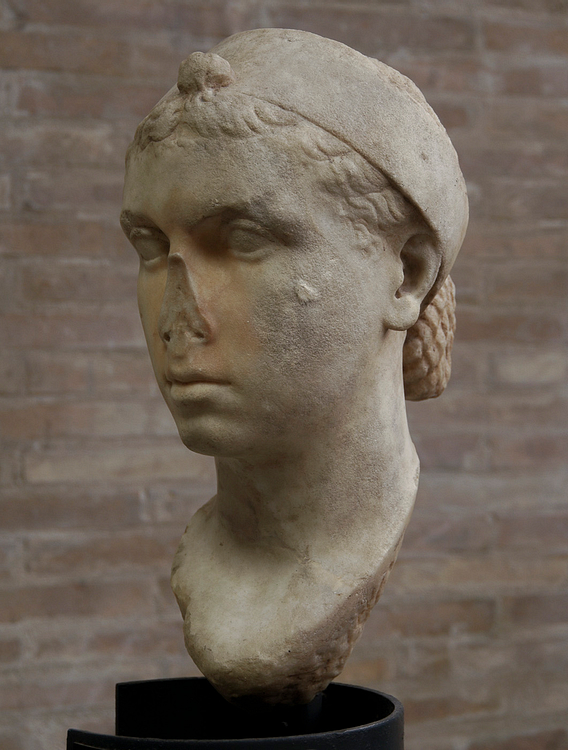
Cleopatra VII (c. 69-30 BCE) was the last ruler of Egypt before it was annexed as a province of Rome. Although arguably the most famous Egyptian queen, Cleopatra was actually Greek and a member of the Ptolemaic Dynasty (323-30 BCE) which ruled Egypt after the death of Alexander the Great (lived 356-323 BCE). Cleopatra is probably best known for her love affair with the Roman general and statesman Mark Antony (lived 83-30 BCE) as well as her earlier affair with Julius Caesar (lived 100-44 BCE) but was a powerful queen before her interaction with either.
She was fluent in a number of languages, is reported to have been extremely charming, and was the most effective among the later Ptolemaic pharaohs of Egypt. Her involvement with Mark Antony brought her into direct conflict with Octavian Caesar(later known as Augustus Caesar, r. 27 BCE-14 CE) who would defeat Cleopatra and Antony and the Battle of Actium in 31 BCE, ending her reign. She and Antony would then both commit suicide the following year.
YOUTH & SUCCESSION
In June of 323 BCE, Alexander the Great died and his vast empire was divided among his generals. One of these generals was Ptolemy I Soter (r. 323-282 BCE), a fellow Macedonian, who would found the Ptolemaic Dynasty in ancient Egypt. The Ptolemaic line, of Macedonian-Greek ethnicity, would continue to rule Egypt until the rise of the Roman Empire and the death of the last Egyptian queen, Cleopatra VII.
Cleopatra VII Philopator was born in 69 BCE and ruled jointly with her father, Ptolemy XII Auletes. When she was eighteen years old, her father died, leaving her the throne. Because Egyptian tradition held that a woman needed a male consort to twelve-year-olde-year old brother, Ptolemy XIII, was ceremonially married to her. Cleopatra soon dropped his name from all official documents, however, and ruled alone.
The Ptolemies, insisting on Macedonian-Greek superiority, had ruled in Egypt for centuries without ever learning the Egyptian language or embracing the customs. Cleopatra, however, was fluent in Egyptian, eloquent in her native Greek, and proficient in other languages as well. Because of this, she was able to communicate easily with diplomats from other countries without the need of a translator and, shortly after assuming the throne, without bothering to hear the counsel of her advisors on matters of state. The historian Plutarch writes,
It was a pleasure merely to hear the sound of her voice, with which, like an instrument of many strings, she could pass from one language to another; so that there were few of the barbarian nations that she answered by an interpreter.
CLEOPATRA & CAESAR SEEMED TO STRIKE UP AN INSTANT AFFINITY FOR EACH OTHER.
Her habit of making decisions and acting on them without the counsel of the members of her court upset some of the high ranking officials. One example of this was when she ordered the deaths of the sons of the King of Syria when they came to the court requesting her assistance.
In 48 BCE her chief advisor, Pothinus, along with another, Theodotus of Chios, and the General Achillas, overthrew her and placed Ptolemy XIII on the throne, believing him to be easier to control than his sister. Cleopatra and her half-sister, Arsinoe, fled to Thebaid.
POMPEY, CAESAR & THE COMING OF ROME
At about this same time the Roman general and politician, Pompey the Great, was defeated by Julius Caesar at the Battle of Pharsalus. Pompey was the state-appointed guardian over the younger Ptolemy children and, on his campaigns, had spent considerable time in Egypt. Believing he would be welcomed by friends, Pompey fled from Pharsalus to Egypt but, instead of finding sanctuary, was murdered under the gaze of Ptolemy XIII as he came on shore at Alexandria.
Caesar's army was numerically inferior to Pompey's and it was believed that Caesar's stunning victory meant that the gods favoured him over Pompey. Further, it seemed to make more sense to Ptolemy XIII's advisor Pothinus to align the young king with the future of Rome rather than the past.

Cleopatra VII
Upon arriving in Egypt with his legions, in pursuit of Pompey, Caesar was allegedly outraged that Pompey had been killed, declared martial law, and set himself up in the royal palace. Ptolemy XIII fled to Pelusium with his court. Caesar, however, was not about to let the young ruler slip away to foment trouble and had him brought back to Alexandria.
Cleopatra was still in exile and knew there was no way she could simply walk into the palace unmolested. Recognizing in Caesar her chance to regain power, she had herself rolled in a rug, ostensibly a gift for the Roman general, and carried through the enemy lines to the palace and presented to Caesar. She and Caesar seemed to strike up an instant affinity for each other and, by the next morning when Ptolemy XIII arrived to meet with Caesar, Cleopatra and Caesar were already lovers. The young pharaoh was outraged.
ANCIENT WRITERS UNIFORMLY PRAISE CLEOPATRA'S INTELLIGENCE & CHARM OVER HER PHYSICAL ATTRIBUTES.
CLEOPATRA & JULIUS CAESAR
Ptolemy XIII turned to his general Achillas for support and war broke out in Alexandria between Caesar's legions and the Egyptian army. Caesar and Cleopatra were besieged in the royal palace for six months until Roman reinforcements were able to arrive and break the Egyptian lines.
Before the victory, however, Cleopatra's half-sister, Arsinoe, who had returned with her, fled the palace for Achillas' camp and had herself proclaimed queen in Cleopatra's place. Ptolemy XIII drowned in the Nile attempting to escape after the battle and the other leaders of the coup against Cleopatra were killed in battle or shortly afterwards. Arsinoe was captured and sent to Rome in defeat but was spared her life by Caesar who exiled her to live in the Temple of Artemis at Ephesus where she would remain until 41 BCE when, at Cleopatra's urging, Mark Antony had her executed.
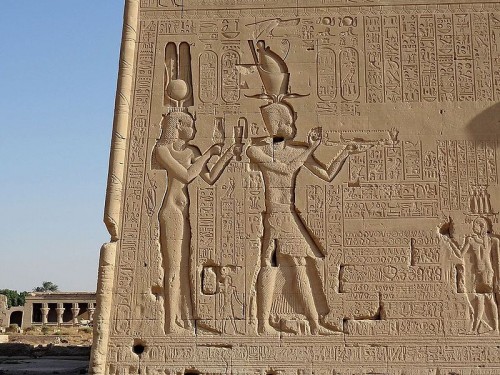
Relief of Cleopatra VII and Caesarion at the Dendera Temple
Cleopatra travelled through Egypt with Caesar in great style and was hailed by her subjects as Pharaoh. She gave birth to a son, Ptolemy Caesar (known as Caesarion) in June of 47 BCE and proclaimed him her heir. Caesar himself was content with Cleopatra ruling Egypt as the two of them found in each other the same kind of stratagem and intelligence, bonding them together with a mutual respect.
In 46 BCE, Caesar returned to Rome and, shortly after, brought Cleopatra, their son, and her entire entourage to live there. He openly acknowledged Caesarion as his son (though not his heir) and Cleopatra as his consort. As Caesar was already married to Calpurnia at this time, and the Roman laws against bigamy were strictly adhered to, many of the members of the Senate, as well as the public, were upset by Caesar's actions.
CLEOPATRA & MARK ANTONY
When Caesar was assassinated in 44 BCE, Cleopatra fled Rome with Caesarion and returned to Alexandria. Caesar's right-hand man, Mark Antony, joined with his grandnephew Octavian and friend Lepidus to pursue and defeat the conspirators who had murdered Caesar. After the Battle of Phillipi, at which the forces of Antony and Octavian defeated those of Brutus and Cassius, Antony emerged as ruler of the eastern provinces, including Egypt, while Octavian held the west.

Silver Tetradrachm portraying Antony and Cleopatra
In 41 BCE, Cleopatra was summoned to appear before Antony in Tarsus to answer charges she had given aid to Brutus and Cassius. Cleopatra delayed in coming and then delayed further in complying with Antony's summons, making it clear that, as Queen of Egypt, she would come in her own time when she saw fit. Egypt was, at this time, teetering on the edge of economic chaos but, even so, Cleopatra made sure to present herself as a true sovereign, appearing in luxury on her barge, dressed as Aphrodite.
She came sailing up the river Cydnus in a barge with gilded stern and outspread sails of purple, while oars of silver beat time to the music of flutes and fifes and harps. She herself lay all along, under a canopy of cloth of gold, dressed as Venus in a picture, and beautiful young boys, like painted Cupids, stood on each side to fan her. Her maids were dressed like Sea Nymphs and Graces, some steering at the rudder, some working at the ropes...perfumes diffused themselves from the vessel to the shore, which was covered with multitudes, part following the galley up the river on either bank, part running out of the city to see the sight. The market place was quite emptied, and Antony at last was left alone sitting upon the tribunal while the word went, through all the multitude, that Venus was come to feast with Bacchus for the common good of Asia. (Plutarch)
Mark Antony and Cleopatra instantly became lovers and would remain so for the next ten years. She would bear him three children and he considered her his wife, even though he was married, first, to Fulvia and then to Octavia, the sister of Octavian. He eventually divorced Octavia to marry Cleopatra legally.
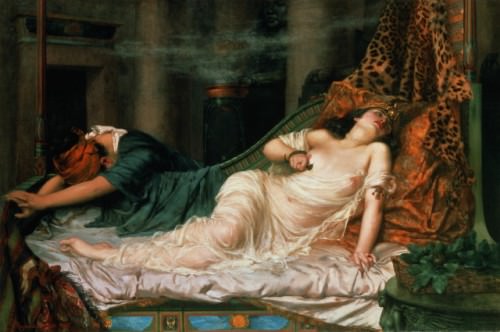
Cleopatra's Death
ROMAN CIVIL WAR & CLEOPATRA'S DEATH
During these years, Antony's relationship with Octavian would steadily disintegrate to the point where civil war broke out.Cleopatra's and Antony's forces were defeated by Octavian's at the Battle of Actium in 31 BCE and, a year later, they both committed suicide. Antony, upon hearing the false report of Cleopatra's death, stabbed himself. He learned, too late, that she still lived and Octavian allowed him to be brought to the queen where he died in her arms.
Octavian then demanded an audience with the queen where the conditions of her defeat were made plain to her. The terms were hardly favorable and Cleopatra understood she would be brought to Rome a captive to adorn Octavian's triumph.Recognizing that she would not be able to manipulate Octavian as she had Caesar and Antony, Cleopatra asked for, and was granted, time to prepare herself.
She then had herself poisoned through the bite of a snake (traditionally an asp, though most scholars today believe it was an Egyptian cobra). Octavian had her son Caesarion murdered and her children by Antony brought to Rome where they were raised by Octavia; thus ended the Ptolemaic line of Egyptian rulers.
Although traditionally regarded as a great beauty, the ancient writers uniformly praise her intelligence and charm over her physical attributes. Plutarch writes:
Her own beauty, so we are told, was not of that incomparable type that immediately captivates the beholder. But the charm of her presence was irresistible and there was an attraction in her person and in her conversation that, along with a peculiar force of character in her every word and action, laid all who associated with her under her spell.
Cleopatra has continued to cast that same spell throughout the centuries since her death and remains the most famous queen of ancient Egypt. Movies, books, television shows, and plays have been produced about her life and she is depicted in works of art in every century up to the present day. Though she was Macedonian-Greek, not an Egyptian, she has come to symbolize ancient Egypt in the popular imagination more than any other Egyptian monarch.
Clovis I › Who Was
Definition and Origins
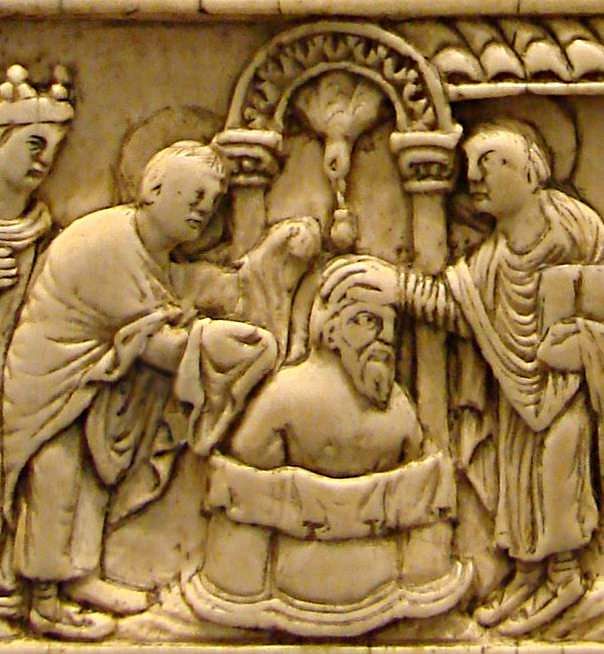
Clovis I (or Chlodovech, 466-511 or 513 CE), king of the Franks, is considered the founding father of the Merovingian dynasty, which would continue for over 200 years. Clovis became king at the age of 15, and by the time of his death 30 years later, he had become the first king to rule over all the Frankish tribes, a firm ally of the Byzantine Empire, and a Christian king. Clovis's policies, and military brilliance, consolidated the regions of Gaul under his rule and, today, he is considered the founder of France.
CLOVIS'S RISE TO POWER
Towards the end of the 5th century CE, the Roman Empire in the west was dying. Aside from its economic decline, the empire was being bombarded on all sides by a series of barbaric attacks from the Huns, the Visigoths, and the Ostrogoths. In 410 CE Rome even succumbed to a three-day siege by the Gothic king Alaric. Finally, in 476 CE, with the overthrow of Emperor Romulus Augustulus, the empire in the west fell. With the demise of Rome, many of the barbaric tribal kings carved out a portion of the old empire for themselves. One of these barbarians would conquer Gaul and establish a family dynasty that would last for over two centuries. His name was Chlodovech - known to history as Clovis I.
CLOVIS ASSUMES THE THRONE
In 481 CE, Clovis, the founding father of the Merovingian dynasty, assumed the throne at the tender age of 15 when his father Childeric, king of a Germanic tribe known as the Salian Franks, died. The pagan king who had fought alongside the Romans against the Huns was honored in death as he had been in life: buried along with weapons, gold, jewelry, and 15 horses. The family name "Merovingian" comes from Clovis's grandfather Merovech, who had also fought alongside the Romans, dying in 456 CE. The young Frankish king had been prepared well by his father and wasted little time in establishing himself as a major force in Europe when, at the age of 20, he opposed Syagrius, the last Roman governor of Gaul.
IN 481 CE, CLOVIS, THE FOUNDING FATHER OF THE MEROVINGIAN DYNASTY, ASSUMED THE THRONE AT THE TENDER AGE OF 15.
CLOVIS'S CONQUEST OF GAUL
Along with a number of allies (including his cousins Ragnachar and Chararic), Clovis fought Syagrius at the Battle of Soissons in 486 CE and soundly defeated him. To avoid capture, Syagrius fled to Toulouse, a city located in southwestern Gaul, where he hoped to find refuge with the young Visigothic king Alaric II. Clovis and his army followed Syagrius and demanded his release. Alaric, wanting no part of a war with Clovis, surrendered him. Syagrius was returned to Soissons where he was reportedly beheaded. Although Clovis and Alaric had reached their agreement and parted ways, this would not be the last time that the two would meet, nor would the next time end so amicably. By the end of the year, Clovis had taken the cities of Rouen, Reims, and Paris and, by 491 CE, he had control of the entire west. He had also, by this time, ordered the assassination of the Frankish kings Chararic and Ragnachar, formerly his allies and possibly his relatives, and taken their kingdoms for himself.
Years later, English historian Edward Gibbon would write on Clovis's early conquest of Gaul:
When he first took the field, he had neither gold and silver in his coffers, nor wine and corn in his magazines; but he imitated the example of Caesar … and purchased soldiers with the fruits of conquest. After each successful battle or expedition the spoils were accumulated in one common mass; every warrior received his proportionable share, and the royal prerogative submitted to the equal regulations of military law. The untamed spirit of the barbarians was taught to acknowledge the advantages of regular discipline.
In 495 CE Clovis further increased his supremacy in Gaul when he drove the Alemani back across the upper Rhine River.According to some sources (primarily Gregory of Tours) his later victories over the Alemani (in 496 and 506 CE) influenced his decision to convert to Christianity.
CONVERSION TO CHRISTIANITY
Although raised a pagan (according to some historians, he would be the last of the pagan kings), Clovis realized that a conversion to Christianity would be extremely beneficial to him if he ever hoped to secure the loyalty of all of the Frankish people. According to Gregory of Tours, his conversion came, in part, due to his marriage to the Burgundian princess Clotilde (daughter of Chilperic); her family was Arian, but she was not. According to the historian Roger Collins, however, Gregory should not be completely trusted in his account. Collins writes, "Unlike the reign of Theodoric, there is very little strictly contemporary evidence for that of Clovis" and further notes that the evidence which is available "makes it virtually certain that Clovis was a Christian by around the year 486 CE" (110). Other historians, of course, disagree with Collins and claim that Gregory's account should be considered. Even if he is viewed by some as unreliable, Gregory of Tours is one of the few sources on the reign of Clovis and his conversion to Christianity. Gregory writes:
Clovis took to wife Clotilde, daughter of the Burgundians and a Christian. The queen unceasingly urged the king to acknowledge the true God, and forsake idols. But he could not in any wise be brought until war broke out with the Alamani … The two armies were in battle and there was great slaughter. Clovis' army was near to utter destruction. He… raised his eyes to heaven, saying … If thou shalt grant me victory over these enemies… I will believe in thee and be baptized in thy name.
According to Gregory, Clovis was victorious and acknowledged the Christian god through baptism. He previously resisted it strenuously, however, owing in large part to Clotilde's insistence on baptising their children. Clovis refused to have his first born son baptised and so Clotilde had the child baptised secretly; afterwards, the boy fell ill and died. When their second son was born, he, too, was secretly baptized and, like his brother, also fell ill. This time, however, Clotilde prayed to God for his recovery and, according to Gregory of Tours, he became well. Soon after this event, Clovis was victorious against the Alemani in 496 and 506 CE and attributed his victories, and his son's life, to his god. Clovis was inspired by his newly found religious zeal to wage war against the Arian Visigoths which would be some of his most successful military campaigns. This crusade would ultimately push the Visigoths back into Spain and provide greater security for the realm of the Franks.
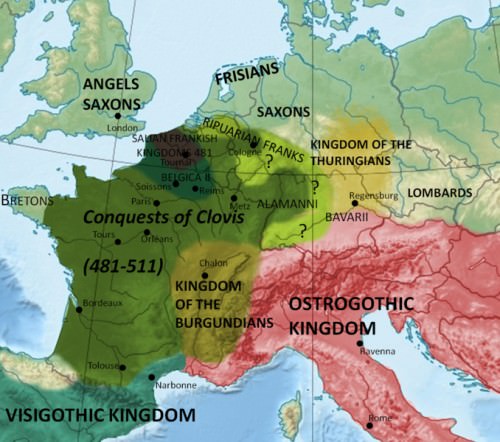
Conquests of Clovis I
His conversion, administered by the bishop of Reims, would not only ensure the loyalty of the conquered provinces but also recognition by Anastasius, the emperor of the Eastern Roman Empire, who was as interested in the success of those who shared his brand of Christianity as he was in the downfall of those who did not.
CLOVIS & THE GOTHS
After his conversion, and with the support of his people and the church, Clovis continued his war with the Visigoths (a struggle he faced throughout his reign), eventually meeting them at the Battle of Vouille in 507 CE at near Poitiers, a city in west-central Gaul, where he defeated and killed their king, Alaric II. The Ostrogothic king of Italy, Theodoric (who was Alaric's ally) was prevented from helping Alaric by the Byzantine emperor Anatasius because Theodoric owed his allegiance first to the empire who had encouraged his rise to power.
Theodoric, like Alaric, was an Arian Christian, while Anastasius was a Nicean (or Trinitarian) Christian, as Clovis was.Anastasius would not, under any circumstances, allow an Arian king to support another Arian ruler against a "true Christian" such as Clovis. Even if Anastasius had not intervened, however, it is unlikely Theodoric could have joined the battle against Clovis as he was married to Clovis's sister, Audofleda, in 492 CE; a marriage Theodoric himself had sought to bind his kingdom to that of Clovis's in alliance. Theodoric was in a difficult position, however, as he had sent one of his daughters in marriage to Alaric II. His choice in remaining out of the war was finally dictated by Anastasius but, as his later actions would prove, it was hardly the choice Theodoric would have made on his own.
After defeating the Visigoths, Clovis returned to Tours, where he was met by the emperor of the east who presented the victorious king with the purple tunic of a consul. With the Visigoths defeated and his realm secure, Clovis elected to rule his united empire from Paris. Attempts to further expand his domain were hampered by Theodoric's intervention. Clovis had wanted the whole of the Aquitanian provinces which had been under Alaric II's rule but, in 508 CE, Theodoric took control of Provence and, by 511CE, had secured the former Visigothic lands for himself.
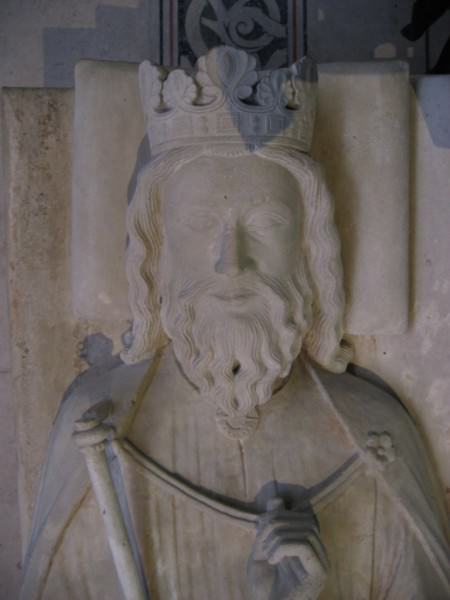
Tomb of Clovis I
DEATH & LEGACY
In November of 511 CE Clovis died (there is some disagreement over the exact year, and some historians cite 513 CE), leaving a kingdom that was a blend of both Roman and Germanic cultures: language, worship, and law. Clovis believed it important to preserve many of the old Roman traditions and, in fact, had modeled his early reign on that of Julius Caesar.Although he has been accused of slaughtering fellow Frankish kings (some even his relatives), it should be noted that this practice was hardly unusual for the time. By the time of his death, he had extended his authority from the north and west, southward to the Pyrenees. He had defeated the Alemani, Burgundians, and Visigoths; however, his passing would end the expansion of the Franks.
Upon his death, his empire was, according to tradition, divided among his four sons; the “Do-Nothing Kings” who would do little, if anything, to expand their holdings or improve the lives of the people. Clovis's name would live on through his dynasty, the Merovingians, and he is considered the founder of the modern nation of France. History would ultimately Latinize his name to Louis; a name that would live on in French royalty for centuries through 18 kings and remains popular in French culture to the present day.
Confucianism in Ancient Korea › Origins
Ancient Civilizations
Principles of Confucianism were adopted by successive dynasties and kingdoms in ancient Korea, and the study of classic Confucian texts was an important part of education and entrance examinations for the state administration. Confucianism was practised side-by-side with the official state religion of Buddhism and, amongst the lower classes, with shamanism and animism. By and large, Buddhism was the practised religion whilst Confucian principles were adopted for government and public life.
THE PRINCIPLES OF CONFUCIANISM
Confucius (or Kongzi) was a Chinese philosopher who lived in the 6th century BCE and whose work was developed and codified by two important later philosophers, Mencius (or Mengzi) and Xunzi (or Hsun Tzu). Together these three figures created the philosophy known as Confucianism. Chief among its ideals are the importance of a virtuous life, filial piety, and ancestor worship. Also emphasised is the necessity for benevolent and frugal rulers with a high moral standing, the importance of inner moral harmony and its direct connection with harmony in the physical world and that rulers and teachers are important role models for wider society. They must be benevolent in order to win the affections and respect of the populace and not do so by force, which is futile. Politics, therefore, when following Confucian principles tended to focus on the intimacy of relationships rather than institutions.

Daeseongjeon Shrine, Confucian School, Ganneung
Another central pillar of Confucianism is that the moral harmony of the individual is directly related to cosmic harmony; what one does, affects the other. For example, poor political decisions can lead to natural disasters such as floods. An example of the direct correlation between the physical and the moral is evidenced in the saying, 'Heaven does not have two suns and the people do not have two kings.' A consequence of this idea is that, just as there is only one cosmic environment, there is only one true way to live and only one correct political system. If society fails it is because sacred texts and teachings have been misinterpreted; the texts themselves contain the Way but we must search for and find it.
HIERARCHY, RIGHTS, RESPONSIBILITIES, LOYALTIES & A SENSE OF DUTY WERE ALL IMPORTANT CONFUCIAN FEATURES OF KOREAN GOVERNMENT.
Confucianism expounded the importance of four virtues which we all possess: benevolence ( jen ), righteousness ( i ), observance of rites ( li ) and moral wisdom ( te ). A fifth was later added - faith - which neatly corresponded to the five elements (in Chinese thought) of earth, wood, fire, metal and water. Once again, the belief that there is a close link between the physical and moral spheres is illustrated. By stating that all men have such virtues, two ideas are consequent: education must nurture and cultivate them and all men are equal - 'Within the four seas all men are brothers.'
ADOPTION BY KOREA
By the 2nd century BCE Confucianism was the official state religion of Han Dynasty China. During the Tang dynasty (618-907 CE) temples were established in the name of Confucius at all administrative capitals and the study of classic Confucian texts (eg Book of History, Book of Changes, Book of Songs, and Spring and Autumn Annals ) became an essential part of the education of every member of the elite classes and they were tested on their knowledge of it in the examinations set for those wishing to join the state's civil service. Then Confucianism was given even greater importance by the subsequent Song dynasty (960-1279 CE). This pattern would be repeated when Confucianism was passed on to Korea, a long-time Chinese trade partner, probably via the Chinese commanderies which controlled the northern territories, especially Lelang, up to the 4th century CE.

Confucius by Wu Daozi
In 372 CE a Confucian Academy was established in the Goguryeo kingdom of northern Korea. Queen Seondeok of Sillaappointed Confucian scholars to her court in 636 CE. A little later, in the Unified Silla Kingdom, which now controlled all of the Korean peninsula, a National Confucian Academy (Kukhak) was founded in 682 CE which was decorated in 717 CE with a number of portraits of Confucius and prominent philosophers brought especially for the purpose from China. In 750 CE it was renamed the National Confucian University ( Taehakkam ). Besides studying at home, many young men of aristocratic families were sent to study in China where they acquired the necessary knowledge of the Confucian classic texts to enter and pass Chinese administration examinations and gain valuable diplomatic experience which they could bring back to Korea and so further their career there.
In 788 CE an examination for state administrators based on Confucian texts was introduced in Korea on the Chinese model.Questions in these papers were largely based on the Analects and the Classic of Filial Piety, both of which contain conversations and sayings attributed to Confucius; especially relevant would have been those regarding proper behaviour and attitudes to superiors and the importance of human relationships to good government. By the 11th century CE 12 private academies, called the Twelve Assemblies ( Sibi to ), had been established which further spread Confucianism. One teacher, in particular, gained great fame, Choe Chung (984-1068 CE), who became known as 'the Confucius of Korea' and who, in 1055 CE, set up the first private Confucian school called the 'School of Nine Studies' ( Kujae haktang ) because there were nine areas of study.
Government and education were the main theatres of Confucian thought, albeit with some application to family roles and responsibilities, especially rituals of ancestor worship in the family shrine within each home. Buddhism, however, remained the official state religion, with shamanism and nature worship the main popular religions, largely pursued by the lower and more rural classes.

Commentaries of the Analects of Confucius
The adoption of Confucianism was not only an indicator of ancient Korea's willingness to adopt elements of Chinese culture but its very principles of filial piety and duty to one's superiors perpetuated a long-standing cultural admiration of all things Chinese and certain political subservience to its large and powerful neighbour. In return, China recognised Korea as 'a country of gentlemen' where 'gentlemen' here is termed junzi, as in the Confucian Analects text.
PRACTICAL APPLICATION & MANIFESTATIONS
Confucianism is notoriously difficult to pin down and elaborate upon, based largely as it is on the original obscure and ambiguous short maxims attributed to Confucius himself, but rulers and ministers endeavoured to transfer certain ideals to their political approach. Hierarchy, rights, responsibilities, loyalties, and a sense of duty were all important Confucian features of Korean government. So too were a belief in a fixed social caste system (eg the Silla Bone Rank system ) which was thought to preserve harmony and balance in the community – the 'know your place' attitude - and more intangible and unquantifiable beliefs such as trustworthiness, diligence, and respect. The historian Jinwung Kim summarises these principles and their effect on both internal and international Korean politics, thus:
Confucianism is based on an ideal model of relations between family members that called for special bonds between sovereign and subject, father and son, and husband and wife, as well as five moral disciplines.Confucianism generalized the family model and relationships of subjects to the state and to an international system. In political terms, these principles meant that a village followed the leadership of venerated elders, and citizens revered a king who was thought of as the father of the state. Generalized to international relations, the Chinese emperor was the big brother of the Joseon king. A conservative philosophy, Confucianism stressed tradition, strict social hierarchies, obedience to superiors, and identification of the father with the monarch. It adopted the proper rite as one of its major virtues and therefore paid careful attention to the performance of ritual. In the international context, it envisioned a China-centered world order. (Kim, J., 187)
Confucianism was not limited to the realm of politics and its principles can be seen in both the art, architecture, and literatureof ancient Korea. In painting and calligraphy, the restraint of Confucian principles was an ideal to be strived for whenever possible. In ceramics, the white porcelain of the Joseon dynasty from the 14th century CE onwards reflects the no-nonsense, ordered and masculine tendencies of Confucian thought and it is no coincidence that it became the favourite of the Korean elite at that time and was widely used in Confucian rituals.

Korean White Porcelain Bottle
Another medium where Confucian themes were popular was screen painting, especially of the eight Chinese characters representing the munja-do or virtues of Confucianism. House architecture might also be dictated by Confucian principles, especially the belief that men and women should be separated and the two sexes, if strangers, should avoid meeting, hence the design of traditional homes of the Joseon dynasty with distinct areas for hosting guests and domestic work. Confucian philosophy also stresses the importance of examining the past and learning from it and this helped foster a Korean sense of history and national identity, as seen in the production of such famous history texts as the Samguk sagi and Samguk yusafrom the 12th century CE.
NEO-CONFUCIANISM
From the 14th century CE a new brand of Confucianism, Neo-Confucianism (again originating in China), gained wide acceptance to the detriment of other faiths, especially Buddhism. With many points of similarity to its original philosophy Neo-Confucianism added a belief that all men could attain higher goals if they applied themselves. This principle resulted in a widening of the eligibility for state examinations, even if those from the elite still had a distinct advantage, such was the necessity for years of classical study prior to the examination. Neo-Confucianism, with its emphasis on clearly defined hierarchical roles for everyone in both public and private life, also resulted in a significant backwards step for women's rights and status in respect to their position in previous Korean thought systems which had drifted away from the original Confucianism.
[bks]
LICENSE
Article based on information obtained from these sources:with permission from the Website Ancient History Encyclopedia
Content is available under License Creative Commons: Attribution-NonCommercial-ShareAlike 3.0 Unported. CC-BY-NC-SA License